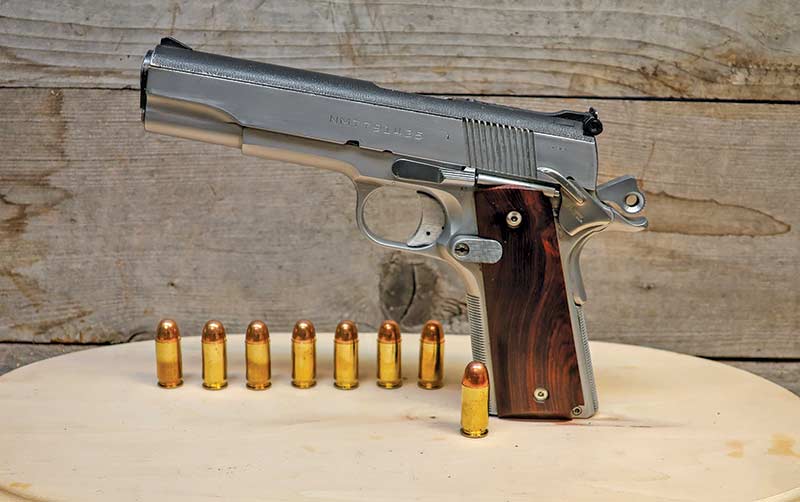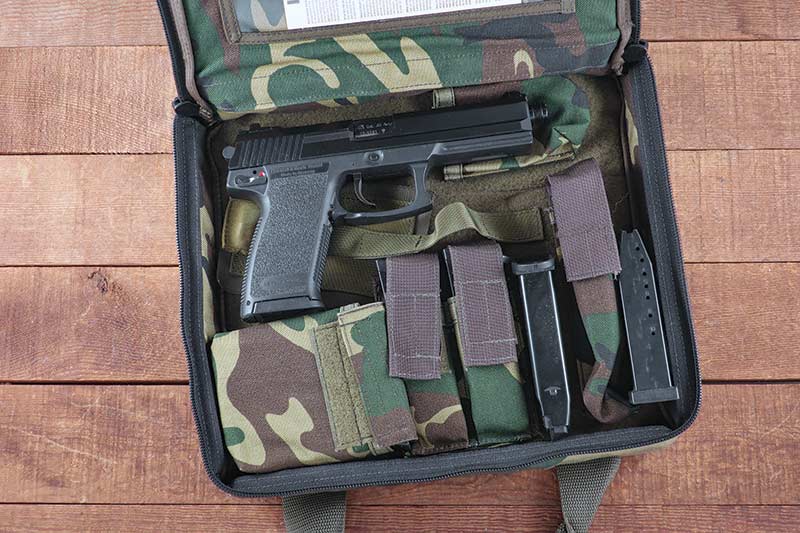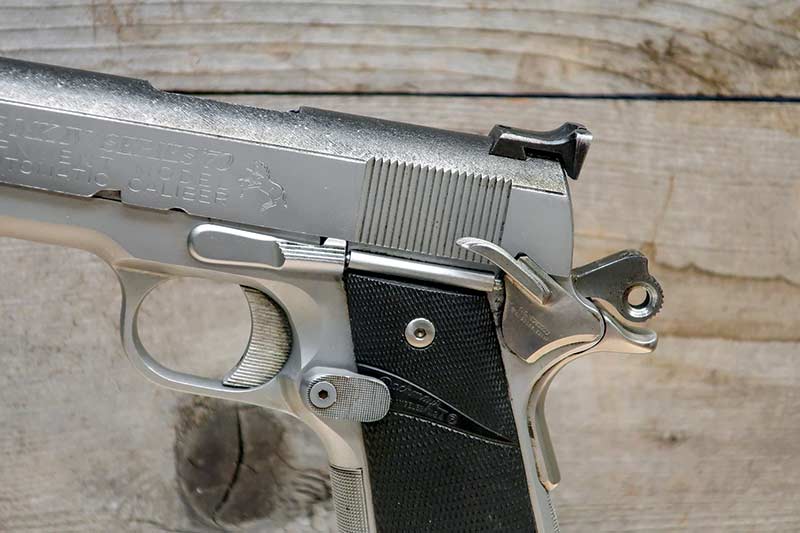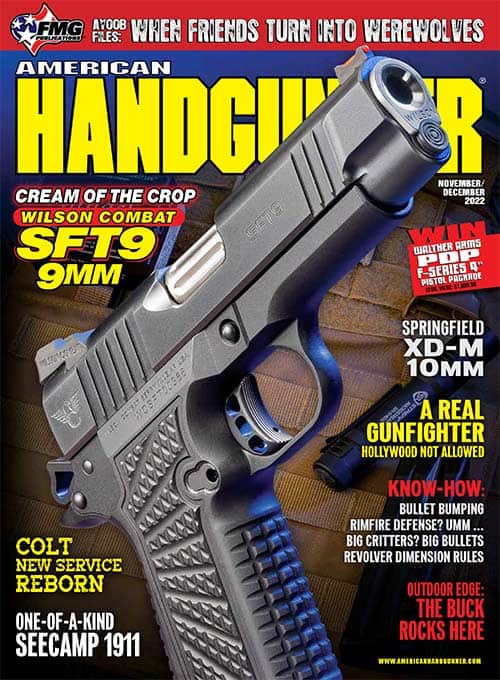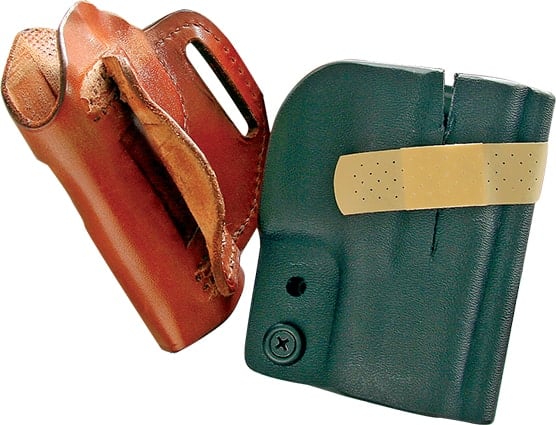A Real American
Gunfighter and His Guns

This Swenson also has a Vietnam heritage, used by a pilot and spending 10 years in
an aircraft carrier armory before being acquired by RJ. It is also a Series ’70, which
RJ turned over to Armand for the Reliability Package and has the first Swenson HiViz
non-adjustable rear sight attached with two set screws.
When those who grew up in my era hear the words “gunfight” or “gunfighter,” we immediately get a vision of something that never existed. Spending many of my Saturdays in the late 1940s at the West Theater to watch western movies with the likes of Roy Rogers, Gene Autry, Hopalong Cassidy and others embedded visions in our minds of what a gunfight is.
A perfect example of a gunfighter was Marshall Matt Dillon of Dodge City. The gunfight took place on Front Street as the good and bad guys faced each other. Or there were gunfighters like the Lone Ranger who always shot the gun out of the bad guy’s hand.
Finding a documented historical reference to a gunfight with two gunfighters facing each other is harder to come up with than winning the lottery without a ticket. The closest example might be Wild Bill Hickok shooting at Dave Tutt at 75 yards while bullets were whizzing. Hickok took his time, aimed carefully and put a .36 caliber ball in Tutt’s heart. There was no fast draw involved. And consider the pure hokum involved in shooting a gun from someone’s hand with a maximum speed draw from leather.
Gunfighters
I have met several movie and TV western stars such as James Arness, who portrayed Matt Dillon, Clint Walker, who was Cheyenne, James Drury, The Virginian and Buck Taylor, who was Newly O’Brien. All seem to be especially nice fellows who filled a role.
I have also met and, in a couple of cases, got to know several real gunfighters quite well. These include Col. Charles Askins, Walter Walsh (an FBI agent responsible for capturing a gang in the 1930s), Bill Jordan (Border Patrol Chief Inspector) and Col. Rex Applegate (a member of the original OSS and held the rank of colonel in both the United States and Mexico militaries).
I also was privileged to know Col. John Dean Cooper, whom all of us know as Jeff. He entered World War II with a mismatched pair of .45s, a 51/2″ Colt Single Action .45 Colt and a .45 ACP Model 1911. He used the SA to good effect the first time. However, he felt it was too slow to load, especially in the dark. So, he switched to the Model 1911 and used it at least twice with the same results. He went on to spend many years advocating the 1911 and teaching The Proper Technique of the Pistol. We will never know how many lives his instruction saved. All of these men are now history and we will never see their like again
True American Gunfighter
It has been my great privilege recently to meet a true gunfighter. Robert “RJ” Thomas is one of the original Navy SEALs. He found himself in a gunfight at Hà Tiên, Republic of Vietnam in March 1969. At the time, Navy SEALs were classified as elite extensions of the Navy Underwater Demolition Teams: ST-1 in Coronado, Calif. and ST-2 in Little Creek, Va. Despite attempts at keeping the mission of the SEAL Teams classified, the NVA placed a $10,000 bounty for killing or capturing one of the “Men with Green Faces.”
Two Navy Seawolf (HAL 3) gunships were on a rocket strike mission near the Cambodian border. Troop activity was spotted around the caves from which the Viet Cong/NVA were shelling the nearby village of Hà Tiên with mortars. RJ recounts, “The Seawolf crew spotted activity around Da Dung mountain caves during their first rocket run. As they reloaded for a second rocket run, they yelled for me to board the Seawolf.
Grabbing my binos, my Stoner 63A and my issue S&W 39 on my H-harness, I jumped on board. I was looking for the cave with rails, where the VC were rolling the mortar out, to set up a sniper op. After a couple of rocket passes, the Seawolf was hit with heavy machine-gun fire and crashed at the foot of the mountain. Pilot Lt. Richard Barr’s collective control stick slammed into his helmet visor above his orbit bone, crushing his eye socket and forcing his eye out on his cheek.”
RJ was thrown out the side door more than 30 feet from the copter onto the dry, hard, concrete-like rice paddy, suffering multiple injuries, including cutting his nose loose on the right side of his face and multiple bullet fragment injuries to his chest and shoulder. Between 10 and 20 NVA troops soon descended the mountain advancing on the crash site to kill or capture crash survivors.
Thomas was stunned by the crash and his Stoner 63A was destroyed in the crash. Reaching for the standard-issue SEAL Team 9mm S&W Model 39 in his H-harness, he found it had been ripped off, leaving the pilot’s 1911 A1 as the only weapon left to the SEAL. RJ was able to release the seatbelts on the unconscious pilot and drag him a safe distance from the burning helo. Meanwhile, the second helicopter dropped off PO2 Dan Riordan to help RJ recover PO1 Abbott, .50 gunner, and move the unconscious man farther from the crash, now raging in flames. The co-pilot and second gunner were consumed in the flames. As Thomas dragged the unconscious pilot farther from the burning wreck, incoming fire kicked up dust around the crash.
Thomas laid across the unconscious pilot and pulled the .45 from the pilot’s shoulder holster. Fortunately for what was about to happen, the pilot’s shoulder rig also had two extra magazines and extra ammunition for his .45 in cartridge loops for a total of about 50 rounds. The enemy was closing, and RJ, now prone across the pilot and using the pilot’s helmet as a rest for his wrists, engaged the approaching NVA with the 1911 A1 at over 100 yards. The NVA took cover behind a rice paddy berm and returned un-aimed fire at the wounded men from behind the dike. The NVA would peer over the dike to see if they had taken out the SEAL, and he would shoot back with the old 1911. More than occasionally, a thud sounded, and the head would disappear. Barr came to and asked how he could help. Thomas told him, “Load magazines.” An NVA jumped the dike and charged. He made it about 50 yards before RJ centered him and stoned him at 30 yards.
After 40 minutes on the ground battling the NVA, an Army Slick (transport Huey) attempted to extract the wounded Navy helo crew and SEAL. As the Slick flared to land, the NVA poured point-blank fire into the cockpit of the Huey, hitting pilot Capt. Mike Willsey in the jaw and upper leg, stunning him and knocking his legs off the controls, causing the helo to spin out of control. Co-pilot Lt. Kent Graham regained control of the helo and flew it back to the crash site several yards from the wounded Navy crew and the SEAL. As Thomas loaded the wounded pilot into the rescue helo, he fell to the ground. The NVA again charged and attempted to take out the helo. Capt. Willsey, despite multiple wounds, continued to return fire out of the helo with an M-3 grease gun. A lone NVA charged the front of the helo. Thomas rolled over on the ground and shot the last of the NVA from between the helo landing skids at 10 yards off the nose of the rescue helo. As the Slick extracted from the crash, Thomas manned the single M-60 MG door gun and engaged the remaining NVA behind the berm. Thomas recalled, “It was like sluicing quail on the ground.”
How many NVA did Thomas take down? We will probably never know but consider this. He was an excellent shot, and he had very few rounds left. The “Gunfight at Hà Tiên” may be the last military gunfight in which the wonderful 1911 was employed to dominate the battlefield in the hands of a “gunfighter.”
Citation
Army rescue pilot Lt. Kent Graham submitted Thomas for the Congressional Medal of Honor for saving him and his crew from the charging NVA. Thomas was ultimately awarded the Navy Cross with the citation reading as follows:
“The President of the United States of America takes pleasure in presenting the Navy Cross to Radarman Second Class Robert J Thomas (NSN: 688-7315), United States Navy, for extraordinary heroism on 23 March 1969 while serving with Sea-Air-Land Team TWO (SEAL-Two), Detachment ALFA, Seventh Platoon, during combat operations against communist aggressor forces in the Republic of Vietnam. Embarked in a Seawolf helicopter on a visual reconnaissance and strike mission on Da Dung Mountain near the Cambodian border, the aircraft was struck by enemy ground fire and crashed in an exposed rice paddy. Petty Officer Thomas was thrown from the wreckage, sustaining multiple injuries. Fighting off the stunning effects of shock, he immediately moved to the aid of the helicopter crewmen still in the burning aircraft. Despite the intense flames and the heavy gunfire from both the mountain and a nearby tree line, Petty Officer Thomas managed to remove one of the crewmen to safety and, with the aid of another man who had been dropped onto the site by an accompanying helicopter, succeeded in freeing the trapped pilot from the flaming cockpit. Petty Officer Thomas then made a gallant attempt to rescue the two remaining men trapped beneath the twisted metal, discontinuing his efforts only when driven back by the exploding bullets and rockets of the burning helicopter. After moving the two previously rescued men to a greater distance from the crash site, Petty Officer Thomas realized that Viet Cong troops were steadily advancing on his position. He selflessly threw himself upon the body of one of the wounded men and began returning the enemy fire. His deadly accuracy accounted for at least one enemy dead and held the aggressors at bay until an Army rescue helicopter landed. By his valiant efforts and selfless devotion to duty while under hostile fire, Petty Officer Thomas upheld the highest traditions of The United States Naval Service.”
For a more in-depth recounting of what took place, I recommend Paul Kirchner’s book More Of The Deadliest Men Who Ever Lived, which also includes a chapter on Col. Cooper.
A Quieter Life
RJ retired in 1995 and five years ago moved into my area. He was the contracting officer for the H&K MK 23 SOF Offensive handgun and several other weapons projects from the SAWS to the .50 McMillan sniper rifles. He was in charge of all Navy SEAL shooting schools, from Close Quarter Battle to sniper schools, as well as a shooting member and Officer In Charge Of the Navy Rifle and Pistol Team for several years. He is a Double Distinguished Military Shooter and an A-Class International IPSC shooter. As stated, it has now been my great privilege to meet him. As a bonus, he gave me the privilege of seeing and handling a Gunfighter’s Guns. One indication of RJ’s influence was that he had Armand Swenson rebuild his 1911A1 in the 1970s, and then for the next 25 years, Swenson built Swenson Combat Pistols for the Navy SEALs.
RJ is not only highly partial to the .45 Model 1911, but he also shows his highly refined taste in pistols by choosing those which have been customized by Armand Swenson, who was one of the premier innovative pistolsmiths a half-century ago. He shared a quartet of Swenson .45s as we gathered several times to talk handguns, share Mexican food at Jalapenos and just visit.
Today in our jaded world, entertainers and sports figures are called heroes. It has been an extreme pleasure for me to actually meet and get to know a real hero.

